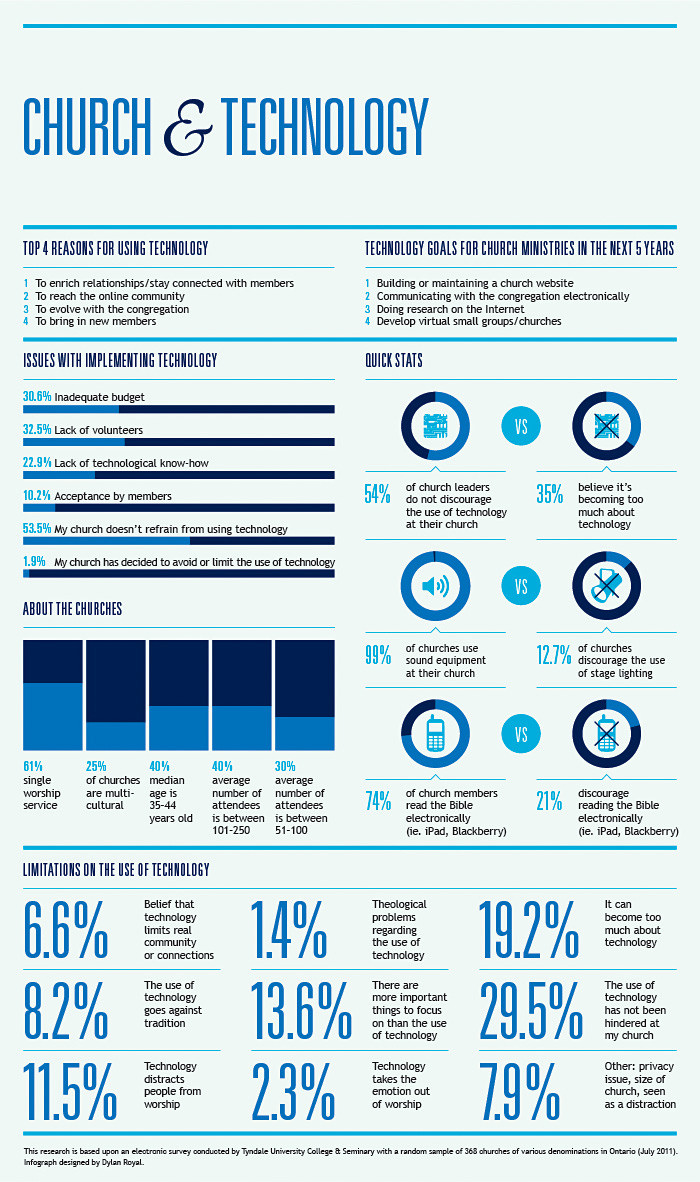We See Through the Glass Darkly, Then Clearly
 One of the transitions that have been taking place within myself, and in many respects this site, is a transition of moving from mobile as something novel for ministry to mobile facilitating behaviors while are more sustainable after the luster wears off. Contributing to this transition is this understanding of the waves of innovation, prosperity, statis, and decline that we see throughout generations of just living (Genesis 8:26). Technologies themselves are driven by these flows. And to see the present moment clearly, you’ve got to bend your eyes into seeing what used to happen.
One of the transitions that have been taking place within myself, and in many respects this site, is a transition of moving from mobile as something novel for ministry to mobile facilitating behaviors while are more sustainable after the luster wears off. Contributing to this transition is this understanding of the waves of innovation, prosperity, statis, and decline that we see throughout generations of just living (Genesis 8:26). Technologies themselves are driven by these flows. And to see the present moment clearly, you’ve got to bend your eyes into seeing what used to happen.
Over the past couple of centuries, we have had a technology revolution every 40 – 60 years, starting with theIndustrial Revolution in 1771, which was characterized by the emergence of machines, factories and canals. This was followed by the age of steam and coal, iron and railways which started in 1829; steel and heavy engineering (electrical, chemical, civil and naval) starting in 1875; and the age of the automobile in 1908. Our present information technology and telecommunications age, whose starting point Perez pegs at 1971, is the fifth such major revolution in that span.
Each such technology revolution is composed of two very different periods, each lasting 20 – 30 years. Theinstallation period is the time of creative destruction, when new technologies emerge from the lab into the marketplace, entrepreneurs start many businesses based on these new technologies, and venture capitalists encourage experimentation with new business models and speculation in new money-making schemes.
Finance and entrepreneurs are the drivers of the installation period, whose key objectives are to leverage the technological revolution to replace or modernize the old with the new. But inevitably, unrealistic expectations in the emerging disruptive technologies lead to over-investments in new companies, unrealistic business models and speculation in all kinds of money-making schemes. These behaviors invariably lead to a financial bubble, which eventually crashes and results in a period of economic stagnation.
After the crash, comes the deployment period, the time of creative construction and institutional recomposition. The now well accepted technologies become the norm. Infrastructures and industries start getting better defined and more stable; and production capital drives long-term growth and expansion by spreading and multiplying the successful business models. New paradigms emerge for guiding innovation. Over time, these new paradigms significantly transform the economy and everything around it, as well as re-shaping social behavior and the institutions of society.
Read the rest of Unleashing the Next Age of Prosperity at Irving Wladawsky-Berger.
Really. Is easy to be caught off guard by the speed and innovations of new behavioral and technological paradigms. We can see that in some of the tone in the Gospel Collation article “The iPhone as Hitchhiker’s Guide to the Galaxy“. And yet it is through this reflective lens of what has happened that we move into doing more clearly what does happen. What surprises us, or could surprise us, is that wisdom and excitement of growing more into what it is that God has created us to be while on earth.
While on earth… Really, we see this tech and our behaviors with it as something that is only a glimpse of what is to come. What we gain in looking at it honestly, retrospectively, and even zealously, is this taste of what will be. However, the key is not getting stuck on the taste that we have now and allowing our glasses to clear with better view, a more full/empty view of what is probable. Our behaviors and perspectives then move towards this viewpoint, only to be challenged and changed again when it’s time for that glass to be refreshed.
Cheap Knowledge, Expensive Meaning
 Involved in a number of conversations this past week, there’s been this sense that there are two types of people involved within IT: those people who are after information, and then those people whom are about meaning. We see a similar break in life when we think about theology and hear that some topics are better discussed in seminary settings, or that the local church is more about applied theological leanings. Is this respect, I wonder if we do more damage than good because meaning then becomes constrained than enabled.
Involved in a number of conversations this past week, there’s been this sense that there are two types of people involved within IT: those people who are after information, and then those people whom are about meaning. We see a similar break in life when we think about theology and hear that some topics are better discussed in seminary settings, or that the local church is more about applied theological leanings. Is this respect, I wonder if we do more damage than good because meaning then becomes constrained than enabled.
Or, at least that’s been the line of thinking that I had come thru my mind when reading Information is Cheap, Meaning is Expensive from The European:
The European: Which brings us to the question of what it means to be alive. Biology, philosophy or religion might answer that question in very different ways.
Dyson: That is a huge and unanswered question that we are unlikely to agree on. Life is whatever you define it to be. There are some clear examples of intelligent life: A kitten is clearly alive, and a human being is clearly an intelligent living being. But very quickly you get into murky areas where the answers are much less clear.
The European: Do we have to embrace the uncertainty?
Dyson: It becomes a question of judgment. Barricelli pushed for a very broad definition of life. In the 1950s, we were just beginning to travel out into space and perhaps discover an answer to whether there might be life and intelligence outside of our planet. Barricelli was concerned that we might not recognize life or intelligence when we saw it, because our definitions of what it takes to be alive or intelligent were so narrow.
There’s more, and I’d encourage you to read and consider some of the propositions put forth in that piece. Specifically, look at your mobile ministry activities, or even your social media and other broadcasting-type activities, where are you simply pushing forward information, but leaving meaning to be narrowly defined, or even alternately defined, by aspects of technology and culture.
Then again, is such kind of thinking and activity even a part of your/your organization’s methods of pushing things forward? Many of those I’ve spoken to are in such a frame of thought and life that they literally don’t think like the other streams of life do around them. For you to think and then do something that’s not be done “quite that way” before is indeed advancing thought and activity beyond certain paradigms isn’t normal. Franky, its painful. So in your moments where you aren’t “making a living” are you stepping into a meaning of life that build on what was known (information) but infuses into life something different?
Yea, its expensive to do such a trip. Am learning that one…
Mobile Advance 10 Questions Series: Antoine RJ Wright
 Over at Mobile Advance continues their 10 Questions interview series of people involved in and around mobile ministry activities.
Over at Mobile Advance continues their 10 Questions interview series of people involved in and around mobile ministry activities.
The latest of these interviews is with Antoine RJ Wright (wait, that’s the guy who runs this place). Here’s a snippet of that interview:
5. What are some of the biggest obstacles to implementing effective mobile ministry? For you/your ministry? For the Christian world in general?
Mobile is still very new for many ministries. Some have just figured out how to get on the Internet train consistently, and mobile adds a layer of knowledge and engagement that should be familiar, but has unique challenges many aren’t ready to answer. For MMM, our challenge is getting people to talk about their challenges and successes with mobile. We’d be just fine if there was an easier way to get folks to document what they are attempting. For the Christian world, mobile is just big. And its unique in every instance. Many don’t focus on discipleship as much as they do activity and teaching, and so they miss that personalized level of life that mobile and discipleship tend to sit on. Mobile requires that kind of on-the-ground relationship…
The Finer Points (and Kerning, and Leading) of Mobile Design

A large sheet showing the Arabic alphabet is completed with hundreds of Koranic markers. A pair of annotated brackets signify a quote or reference to the Koran, and a series of characters grouped together spells out the salutation – Peace be upon him.
Nokia Pure has been specifically designed to accommodate the Koran in Arabic, and the Torah in Hebrew, reflecting the fact that in many parts of the world mobile devices have become an important religious resource.
Now with the first phase of the project near completion, Bruno Maag is looking ahead to the next set of languages. He has started working on Armenian. “Not many people speak it,” he says dryly.
The result of all their efforts, Nokia Pure, is a humanist sans face font – without serifs but with different weights and thickness on the strokes. Maag points out the small details that make the font unique:
Read the rest of Typographer Bruno Maag on Nokia Pure: Exclusive Interview at Nokia Conversations
This is a lot more than most want to know about fonts; but speaks to just how intricate the mobile environment is. You have to include context in every measure, especially in the case of fonts where you are ascribing literacy to the experience.
Carnival of the Mobilists No 253
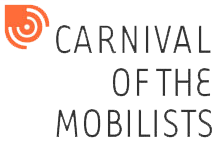 The Carnival of the Mobilists is a monthly blog carnival featuring some of the best perspectives in mobile from around the web. Each month has it hosted at a different website, and this month’s host was Tomi Ahonen/Communities Dominate Brands.
The Carnival of the Mobilists is a monthly blog carnival featuring some of the best perspectives in mobile from around the web. Each month has it hosted at a different website, and this month’s host was Tomi Ahonen/Communities Dominate Brands.
Tomi wrapped the September collection of posts around David Bowie’s Changes – which makes for a rhythmic, unique approach to reading this month’s contributions. Besides my own, do make sure to check out others who were included in the 253rd Carnival of the Mobilits.
Of note to those of you in mobile minsitry (#mobmin), you might want to add to your note books the posts from Martin Wilson, Sacha Vekeman, and Steve and Alison Hoober as these posts have direct corellation to activities in this space.
What I Wish My Pastor Knew About: Responsible Engineering and Technology – from Ministry Theorem
As an engineer, it strikes me as odd sometimes that many Christians I know will expend a great deal of energy and passion arguing about theories of science, while at the same time unquestionably accepting nearly every new technological development that comes along. Perhaps you know Christians to whom mentioning the age of the earth or evolution can trigger heated debates. On the other hand, for these same people, mentioning nuclear power or the need for sustainable energy technologies usually results in blank stares or shrugs.
This seems interesting to me because, while scientific explanations of history can be fascinating (as other essays in this collection have no doubt demonstrated), they rarely impact our daily activities in the way that technology does. After all, technology shapes our lives from the moment we crawl out of bed in the morning (perhaps from our visco-elastic “memory foam” mattress, made from a material revised and adapted for this purpose only within the last 10 years) and step into the shower (where we enjoy an almost immediate flow of water obtained from a massive water treatment plant via a complicated piping system and heated by a water heater powered by natural gas). Consider the impact that ubiquitous electronics technology has each day on how we spend our time (think televisions, computers, digital music players, cell phones, ATM’s).
So, as an engineer, I sometimes wish that my pastor would encourage people to better appreciate the substantial benefits technology (and therefore the exciting work of engineers) provides, while at the same time encouraging people to be more careful about the technologies they buy and use.
Read the rest of What I Wish My Pastor Knew About: Responsible Engineering and Technology (Gayle Ermer) from Ministry Theorem.
This has been sitting in a window/tab to read on my iPad for a few days and (at the time of writing), I’ve still not gotten to reading the entire piece. Still, the subject and initial paragraphs have been intriguing enough to just poke my mind enough in the direction (again) of wondering how technologists can do a better job of relating to non-techincal fields the Godly value of what we do. I mean, we shouldn’t need God to speak on our behalf all the time (ref Exodus 25 as God making out an industry for certain types of engeineers, craftsmen, and tailors), but it sure does feel like that’s the only way that these two groups would come together for the glory of God and benefit of the entire Body.
~ via John Dyer; paragraph breaks inserted into the blockquote for readability
Conversations and Sketchnotes: Reflections from BarCamp 6 in Charlotte
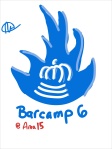 Last Saturday, I attended BarCamp Charlotte 6 (@barcampclt). This "unconference" was in its sixth iteration, and I finally got over there. I wasn’t really sure of what to expect, but came away with a shirt pocket full of business cards, several side pockets of inspiration, and a few sketches that colored my impressions.
Last Saturday, I attended BarCamp Charlotte 6 (@barcampclt). This "unconference" was in its sixth iteration, and I finally got over there. I wasn’t really sure of what to expect, but came away with a shirt pocket full of business cards, several side pockets of inspiration, and a few sketches that colored my impressions.
The day started off by me realizing that it would probably *not* be a good idea to bike to BarCamp. It was the low 40s (F) and I was in no shape going to be able to bike there with it that cool. Sure, it was going to warm up later, but even in driving there, most of us who weren’t already with a cup of coffee in the hand were looking for that warm-cup delievery.
Everyone got settled in as Adam (CPCC) gave us all a headsup for the day’s activities. First, there would be 30 second pitches by anyone who was able to give one for a discussion topic. The topic would get posted on a large wall and then we’d have a few minutes to mark our vote on the topic by marker or crayon. After the voting was over, the eight (8) highest voted pitches would be placed into one of two sessions (four sessions went on at a time).
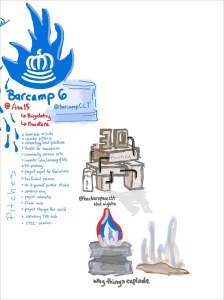
The first session that I attended was about how to build a 3D printer by Hackerspace Charlotte (@hackerspaceclt). This was just one of those *too intriguing to miss* presenations. The presentation also included a piece in its second half called "why things explode," which I have to admit being one of those rare times where I kept hearing someone spout off things I didn’t know and was amazed at. Oh, the 3D printer, it apparently costs $350 for the total amount of materials and Hackerspace Charlotte has sessions on Wednesdays where they show you how to make one. Make your own screws, tools, stands, etc., for $350 and the cost of the plastic? Nice.
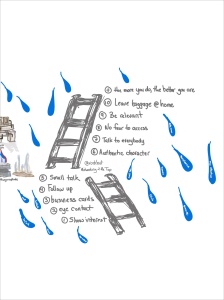
After that was one of the more energetic presenters that I’d seen during the day. Raquel Valez (@rockbot) giving a talk on her top 10 networking tips. From someone who’s merely known her from just following her Twitter timeline, it was impressive that she both did the talk off the cuff but also had 10 solid and very valid tips. IMO, she’s a networking beast and could teach more than networking if she had more time. Was a great talk, and was quite hard to keep with the discussion when others started chiming in (hence the drops of water around the ladder on the sketchnote).
Ah, the sketchnote. See, I had to go that route. There would have been normal notes, but so many people were doing that with iPads. Had to go with my brand ya know. And it goes some decent attention as well. Maybe I should…
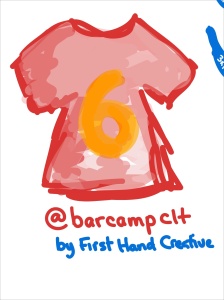
We broke for lunch (I got a BarCamp 6 t-shirt) and then did the pitches and voting again. In this section, I stretched my networking legs a bit and got to talk with several folks who are doing some neat things in and around Charlotte. There’s a lot of energy to just see the entire city do well.
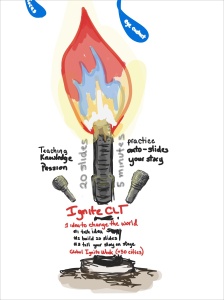
The first talk I attended in the second session was how to give an Ignite Charlotte talk by Bridget Sullivan (@sullybridgetb). Lots of tips there that were applicable for more than just Ignite formatted talks. Now, I do have to admit that I pushed a bit with a question that I had about an interactive talk. And I’ve got ideas on how one could work. But, after getting shot back a bit, I let the sketchnote for that session talk, and I think its something that could come back when its time to submit for topics.
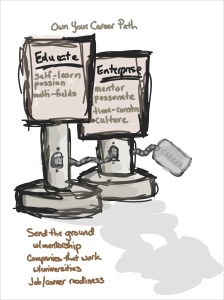
The second and final talk of the day that I attended was about reshaping and refining education given the lack of preparation that people have in coming out of college and those who are in professions but being called to reset themselves in light of jobs and the economy. This talk was led by Bermon Painter (@bermonpainter) and was a nice cap on the emotional and action steps that an event like BarCamp instigates. I think that I was finally comfortable with the crowd because I talked a lot here. But, that’s my heart. Got to change the educational foundations if we are going to do the longest and most sustainable changes to the culture. If there’s a bigger focus on mentoring/discipleship, and then the curriculims focus not on rote subjects but the applicable methods in industries beyond and knitting of those subjects, we can see the changes we desire.
After a few more chats, that was it. The day was long, the weather warmed up, and it was just a bit of a fire ignited in me to continue connecting with several groups and people in the area. I’m looking forward to seeing some of those who attended BarCamp at other engagements in the coming months. And maybe I’ll even get around to fuller conversations with these persons and the initiatives they represent/forward.
One of the attendees of BarCamp and I took some exxtra conversations at Amelie’s Bakery afterwards. I’m really liking that spot as a place to just settle into rest and refreshing. The conversation, much like the connections at BarCamp Charlotte 6, were good towards upping the bar towards how I see and connect with life in this second stanza in Charlotte. BarCamp 7 might see a different me given all of that.
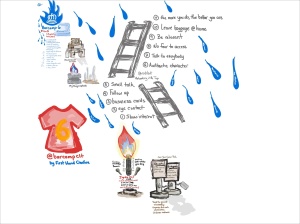
~ crossposted with Blog.AntoineRJWright
Literal Deuternomy 6 Tech, OmniTouch
These words I am commanding you today must be kept in mind, and you must teach them to your children and speak of them as you sit in your house, as you walk along the road, as you lie down, and as you get up. You should tie them as a reminder on your forearm and fasten them as symbols on your forehead. Inscribe them on the doorframes of your houses and gates. (Deuteronomy 6:6-9 NET)
I’m quite interested in the field of wearable computing, especially as I see it relating to the next logical evolution of computing beyond mobile (hardware). OmniTouch is something that I came across while reading. Its a good bit bulky, but does enhance the spatial relationship people can have within computing interfaces.
I also am reminded of seeing something quite similar done with the Nokia N95 smartphone a number of years ago. Nice how history repeats itself, but finds ways of being reinterpreted in another toolset for additional learnings.
Could your practices in digital faith stand seeing digital graffiti of Scripture on the literal hands, hearts, and buildings of man?
[Review] From the Garden to the City – Chapter 8: Mediums
 A few months back, I threw MMM’s hat into the running as a participant for the blog-tour/review of John Dyer’s From the Garden to the City with Church Mag. What I didn’t expect was the chapter that we’d land on Mediums (Chapter 8 ) and how appropriate and challenging it is that MMM gets to play in that space for this particular journey.
A few months back, I threw MMM’s hat into the running as a participant for the blog-tour/review of John Dyer’s From the Garden to the City with Church Mag. What I didn’t expect was the chapter that we’d land on Mediums (Chapter 8 ) and how appropriate and challenging it is that MMM gets to play in that space for this particular journey.
…John arrives at this discussion about Mediums with some interplay and advancing from McLuhan’s medium is the message meme. And where I can see the connections – for example communication tendencies being placed into formality, speed, and difficulty – I can also see some disconnects that are probably a product of my own training, experience, and profession/vocation – my disagreements with the digital native/digital immigrant discussion. And maybe that’s just it with this chapter, and much of the rest of this book, you get this chance to wrestle with how you’ve perceived the medium of connected technologies of our age (polls, Internet, mobile, social networking, etc.) and filter them not so much through what you know and accept, but what makes sense beyond your perceptions…
Read the entire review of Chapter 8: Mediums; and Follow the rest of the blog tour of From the Garden to the City at Church Mag.
Recommeded Purchase
If you haven’t purchased or read From the Garden to the City, I’d encourage you to read it (at least twice) and to take the observations and lessons into your professional and vocational contexts. You won’t agree with everything (you shouldn’t), but you will be challenged and offer the challenges to your immediate spheres towards the kind of (Berean) inspection that is ultimately more valuable and longer lasting than the next channel or opportunity in this virtual space.
